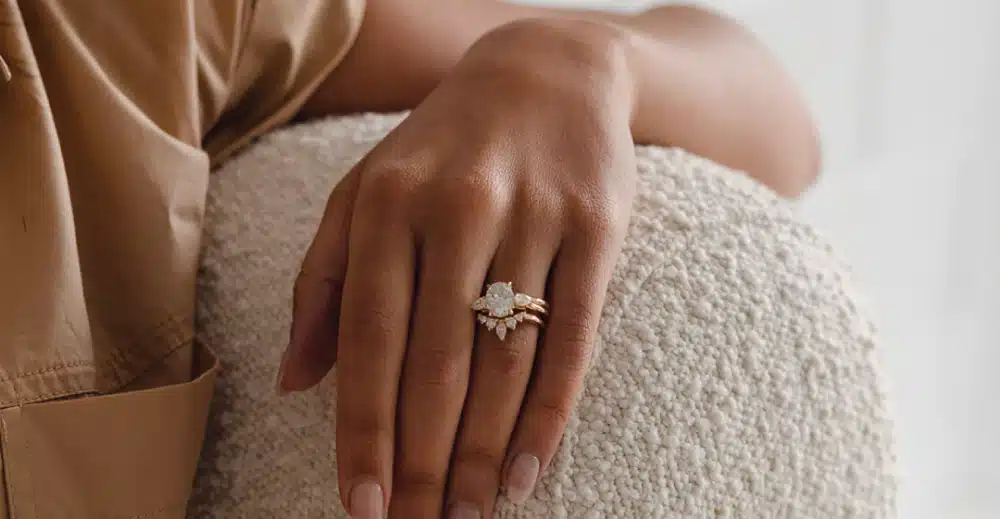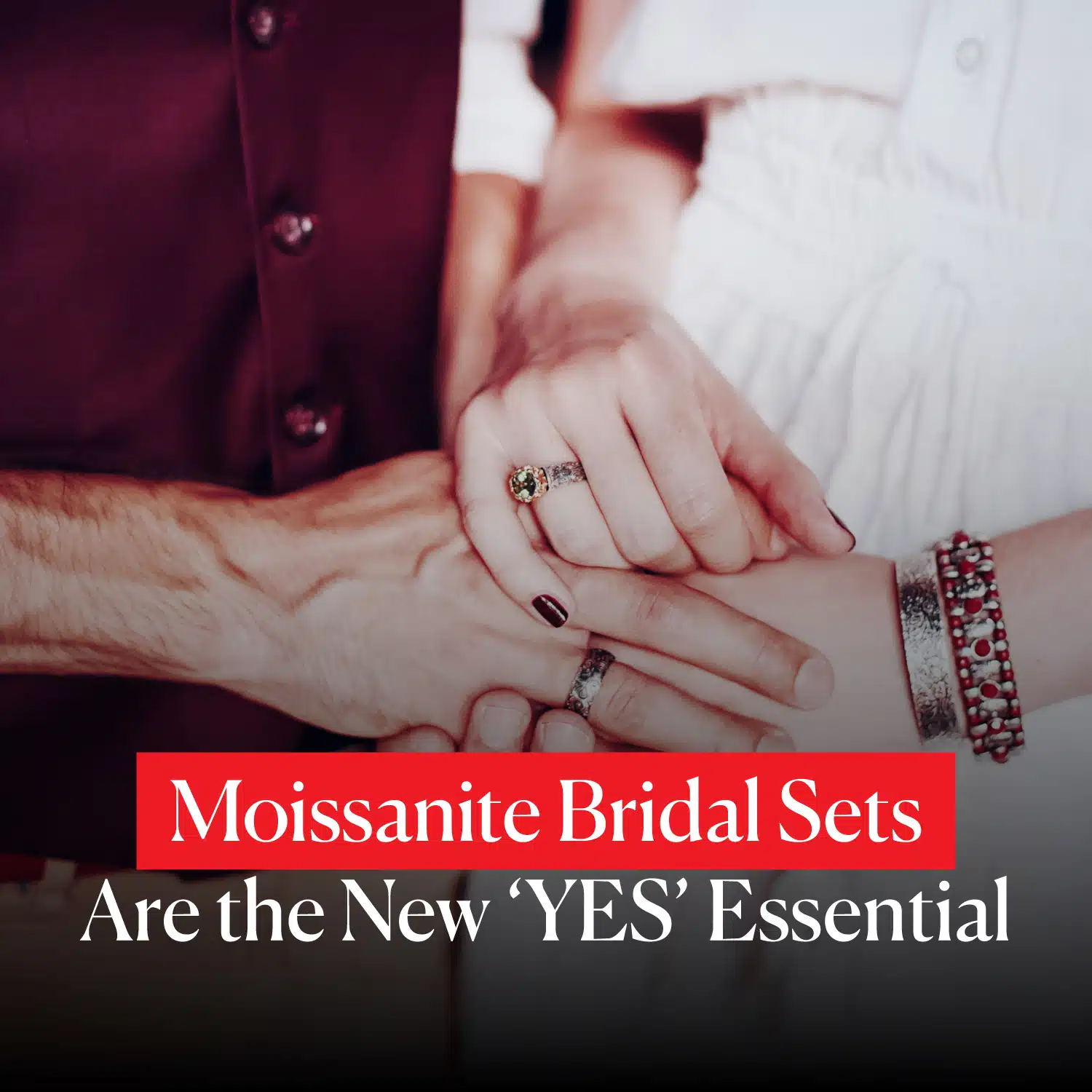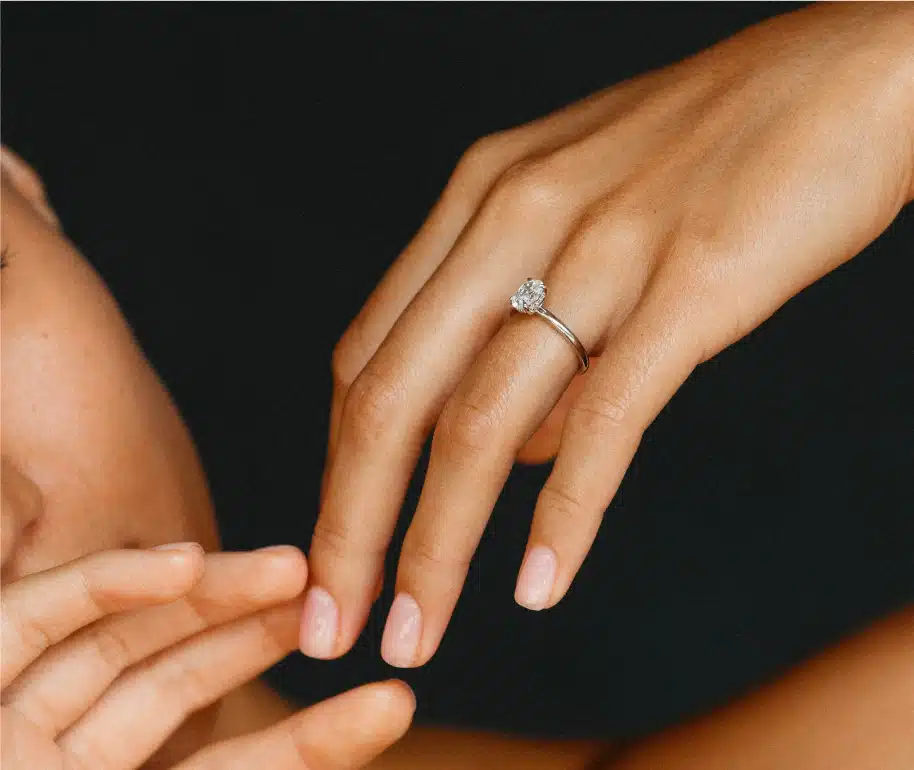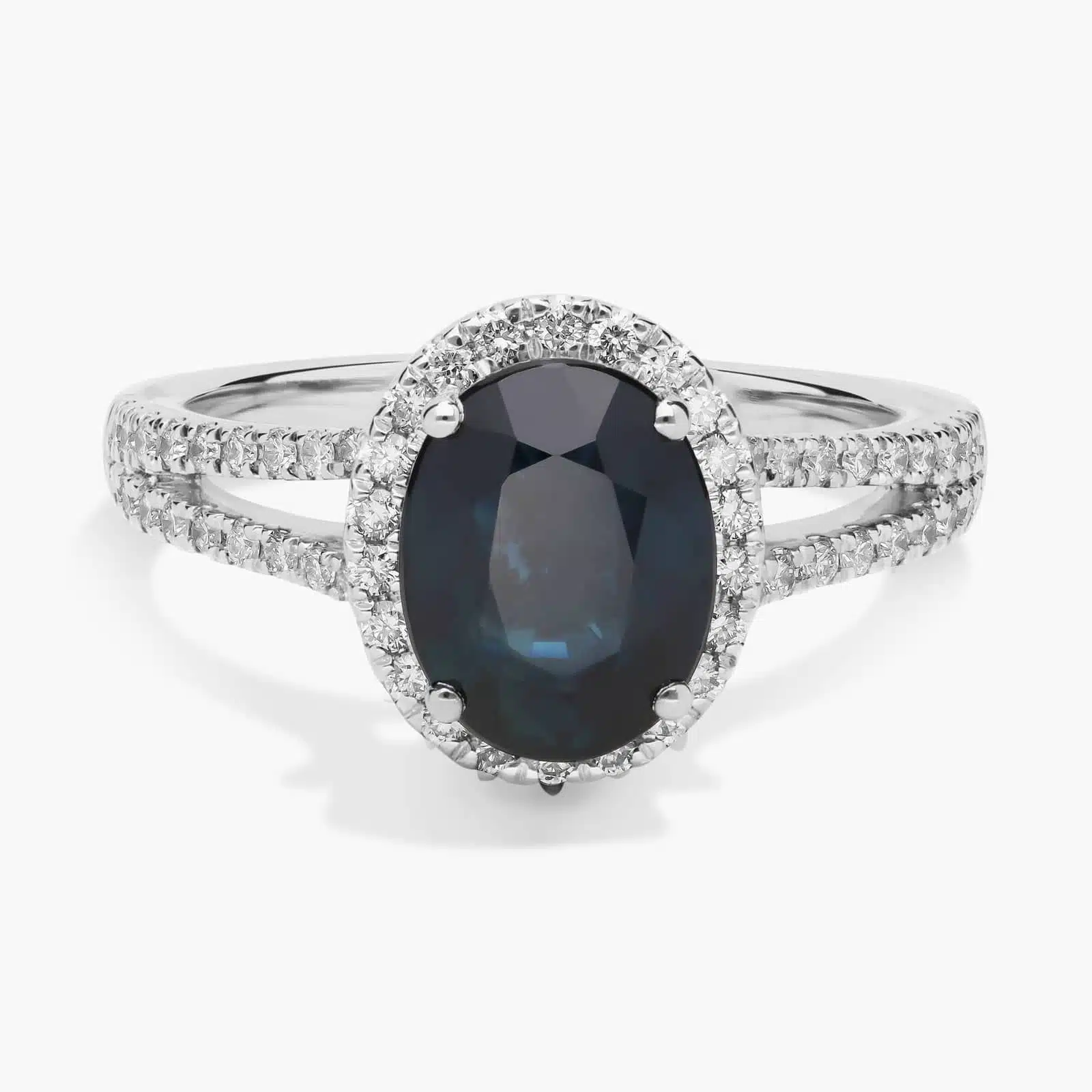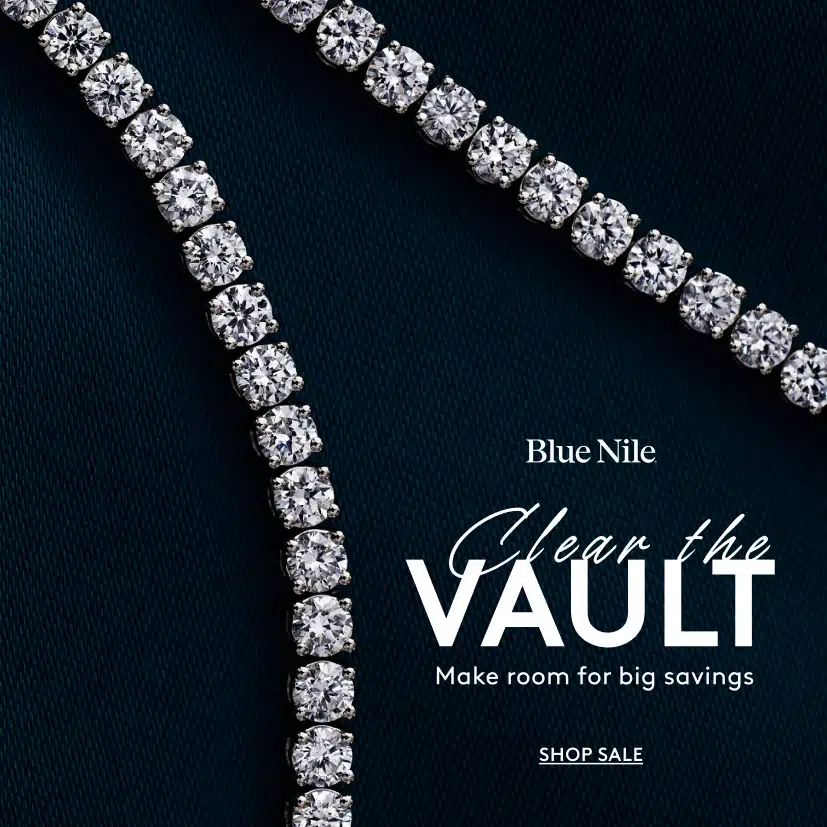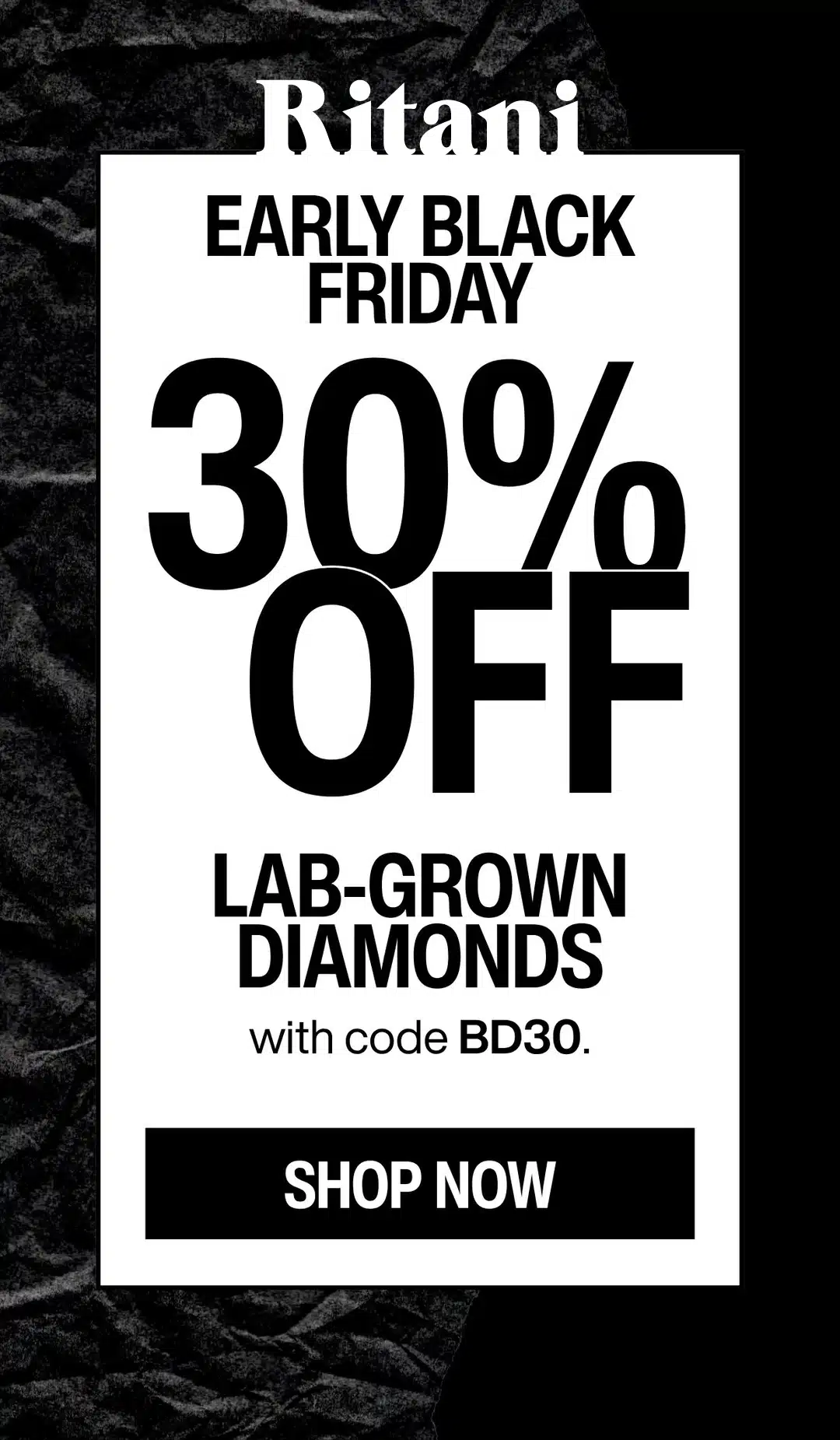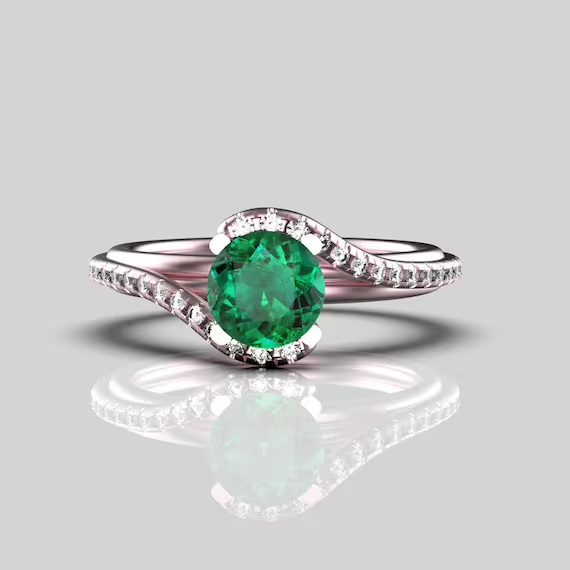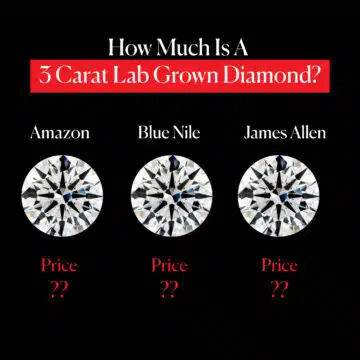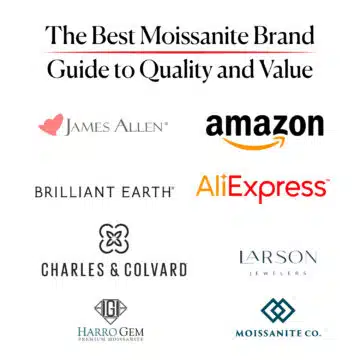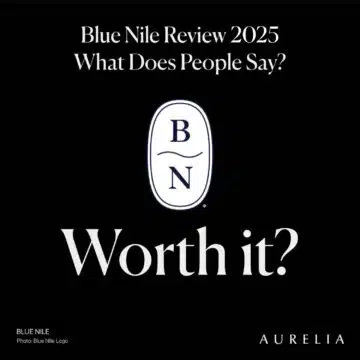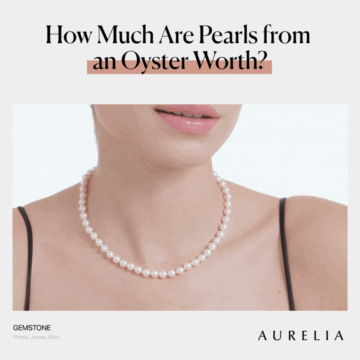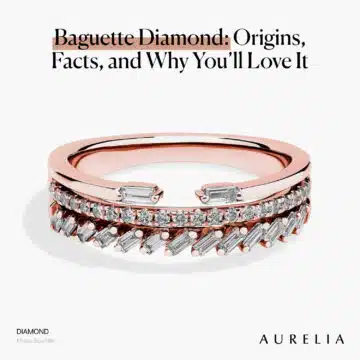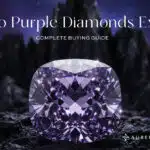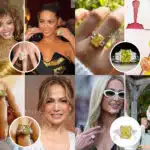Yes, James Allen’s famous 360° diamond videos are the single most powerful tool you have for buying a ring online. But here’s the brutally honest truth the others won’t tell you: that video can also be your worst enemy if you don’t know what you’re looking for.
You’re here because you’re staring at two GIA-certified diamonds on your screen. On paper, they look identical. But in their videos, one seems to sparkle a little more, and it’s part of their premium “True Hearts” collection—for an extra $1,000.
A voice in your head starts whispering, “Is that extra sparkle real, or is this just brilliant marketing? Am I about to overpay for a gimmick?”
I’m Mehedi, and I’m going to be your expert guide through that minefield. I’ve not only analyzed thousands of their diamonds, but I also went completely undercover, spending $16,350 of my own money on a ring specifically to test their entire process, from the checkout to their famous “no questions asked” return policy.
In this review, we’re cutting through the noise. We’ll break down exactly how to use their video technology like a pro, determine if True Hearts is actually worth the money, and stack them up head-to-head against their biggest rival in our James Allen vs. Blue Nile showdown.
You’re about to learn how to buy a diamond with the eyes of an expert. Let’s get into it.
- Industry-best 360° HD videos on every diamond
- Largest online selection of lab-grown diamonds
- Proven 24/7 expert customer support
- Completely risk-free, 30-day return policy
- Free lifetime warranty & maintenance services
- Ring settings are slightly pricier than Blue Nile
- True Hearts™ diamonds carry a price premium
- Limited selection of non-bridal “fashion” jewelry
- The James Allen Superpower: A Masterclass in Buying Smarter
- A Different League: The Expert’s Guide to Fancy Color Diamonds
- The Diamond Hunter's Playbook: How to Master the Filters
- Beyond Diamonds: An Expert Look at Their Gemstones & Moissanite
- The Big Decision: Natural vs. Lab-Grown Diamonds
- The Architect's Playbook: How to Build Your Ring Like a Pro
- The Price Showdown: An Expert Analysis of James Allen's Value
- Decoding True Hearts™: A Gimmick or a Truly Perfect Diamond?
- The James Allen Safety Net: Service, Support & Smart Savings
- The Architect's Playbook: My Step-by-Step Guide to Building a Ring
- A Critical Warning for International Buyers (Taxes, Duties & Fees)
- The Competitor Gauntlet: A Brutally Honest 2025 Showdown
- The Unfiltered Truth: A Deep Dive into James Allen Reviews on Reddit
- The Modern Dilemma: A Brutally Honest Guide to Natural vs. Lab-Grown
- The Unfiltered Truth: A Deep Dive into James Allen Reviews on Reddit
- FAQs About James Allen
- The Final Verdict: My Brutally Honest Recommendation
The James Allen Superpower: A Masterclass in Buying Smarter
When James Allen launched in 2006, they didn’t just build a website; they detonated a bomb in the center of the traditional diamond industry. That bomb was their 360° Diamond Display Technology, and it fundamentally changed the power dynamic between seller and buyer forever.
Before this, buying a diamond online was a blind gamble on a GIA certificate. After, it was like having a jeweler’s loupe on your kitchen table. This isn’t just a “feature”—it is the core of their entire business.
Take a look at a typical product page. That little “360° View” icon isn’t just a gimmick; it’s your new best friend.
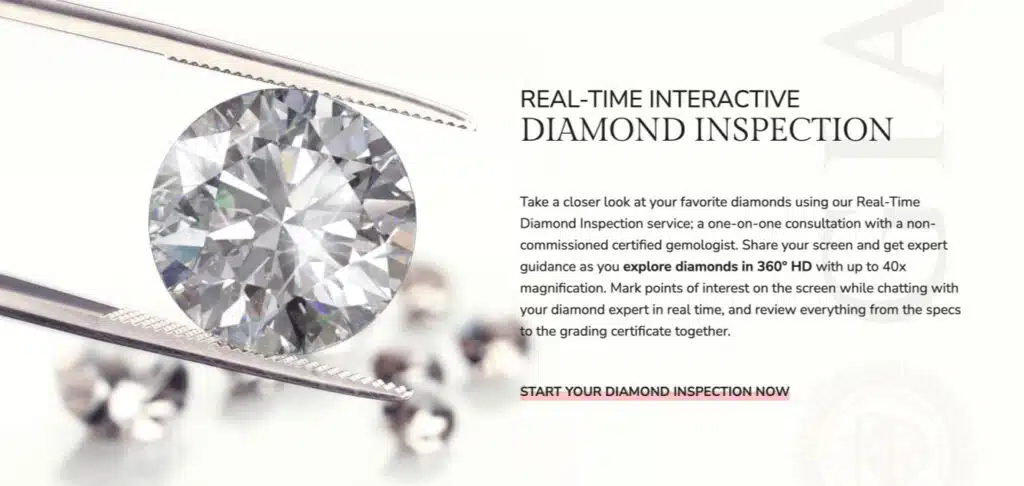
That interactive video window is what separates a smart buy from an expensive mistake. But like any powerful tool, you have to know how to use it correctly.
How to Use the 360° Video Like a Pro (Mehedi’s Checklist)
The video is filmed under intense, perfect lighting, so almost every diamond will look sparkly. Your job is to ignore the generic sparkle and hunt for the truth. Here’s what you, as the expert, are looking for:
The Clarity Hunt (Is it “Eye-Clean”?)
This is the only question that matters for clarity. A GIA report just tells you that an inclusion exists, but the video shows you if it’s actually a problem. Put the magnification on 20x and spin the stone.
Is the inclusion a tiny, faint white speck near the edge? Or is it a dark, distracting crystal right under the main table? An SI1 diamond with a hidden inclusion is a much smarter buy than a VS2 with a central flaw. This tool allows you to find those high-value, eye-clean stones.
The Shape Appeal Test
For any shape other than a round brilliant (like a princess, oval, or pear), the GIA certificate tells you nothing about how attractive its shape is. Is the oval elegantly elongated or short and chubby? Are the points on the pear sharp and defined? The video is the only way to judge the stone’s character and silhouette.
The Light Leakage Check (The Bowtie Killer)
This is my most important tip. The video is the ultimate test for light leakage, which appears as dead or dark spots. The most infamous example is the “bowtie effect” in ovals and pears—a dark, bowtie-shaped shadow in the center that kills brilliance. The certificate will never mention it, but the video makes it impossible to hide.
The Next Level: When You Need a Second Opinion
But what happens when you’ve stared at a video for ten minutes and you’re still not sure if that SI1 inclusion is a deal-breaker? This is where James Allen’s next brilliant feature comes in: the Real-Time Interactive Diamond Inspection.
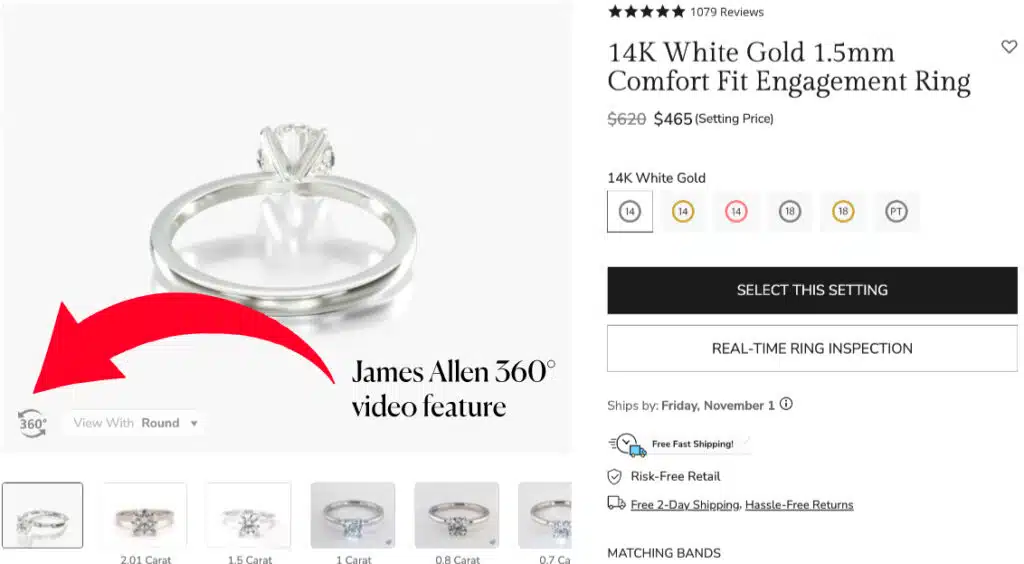
This is your safety net. It’s a free service where you can screen-share with one of their non-commissioned gemologists and look at the exact same 360° video together. You can literally ask them, “That little speck at 2 o’clock—what do you think?” and get an expert’s honest, real-time opinion. It is the perfect bridge between online convenience and in-person expertise.
The Undercover Proof: I Trusted This System with $16,350
This isn’t theoretical advice. As I detail in my full undercover “Is James Allen Legit?” investigation, I used these exact tools to vet the 1.90-carat princess cut diamond I purchased for my test. The GIA report was great, but it was the 360° video that gave me the confidence to click “buy.”
I could personally verify that the VS1 clarity was perfectly eye-clean and that the cut created brilliant, edge-to-edge light return. For all the crucial things to know about James Allen before you buy, understanding how to master this technology is at the top of the list.
The video is James Allen’s promise of transparency, and based on my first-hand experience, it’s a promise they keep.
A Different League: The Expert’s Guide to Fancy Color Diamonds
Alright, let’s step away from the traditional engagement ring world for a moment. If a classic white diamond is a timeless tuxedo, a fancy color diamond is a piece of haute couture. It’s rare, it’s a statement, and the rules for buying one are completely different.
First, throw out the playbook you learned for white diamonds. When you step into the world of fancy colors, the 4Cs get a serious demotion. Here, there is only one ‘C’ that truly matters: Color.
The New #1 Rule: Color Is Everything (And Intensity is King)
A white diamond’s value comes from its lack of color. A fancy diamond’s value comes from the strength and rarity of its color. The GIA grades them on three things:
- Hue: The primary color (e.g., yellow, pink, blue).
- Tone: The lightness or darkness of that color.
- Saturation (Intensity): How strong and pure the color is. This is the big one.
The intensity scale is where you’ll see the price explode. Think of it like this: a “Fancy Light” yellow is a luxury sedan. A “Fancy Vivid” yellow is a supercar. They’re both yellow, but they are not in the same universe of value. Because color is the entire point, the cut is often designed to maximize and deepen the hue, sometimes at the expense of traditional sparkle.
How to Hunt for Fancy Color Diamonds at James Allen
So, how do you find one of these rare gems without getting lost? James Allen’s navigation is actually quite smart about this. They don’t lump these stones in with their main diamond search; they give them their own dedicated section with visual filters.
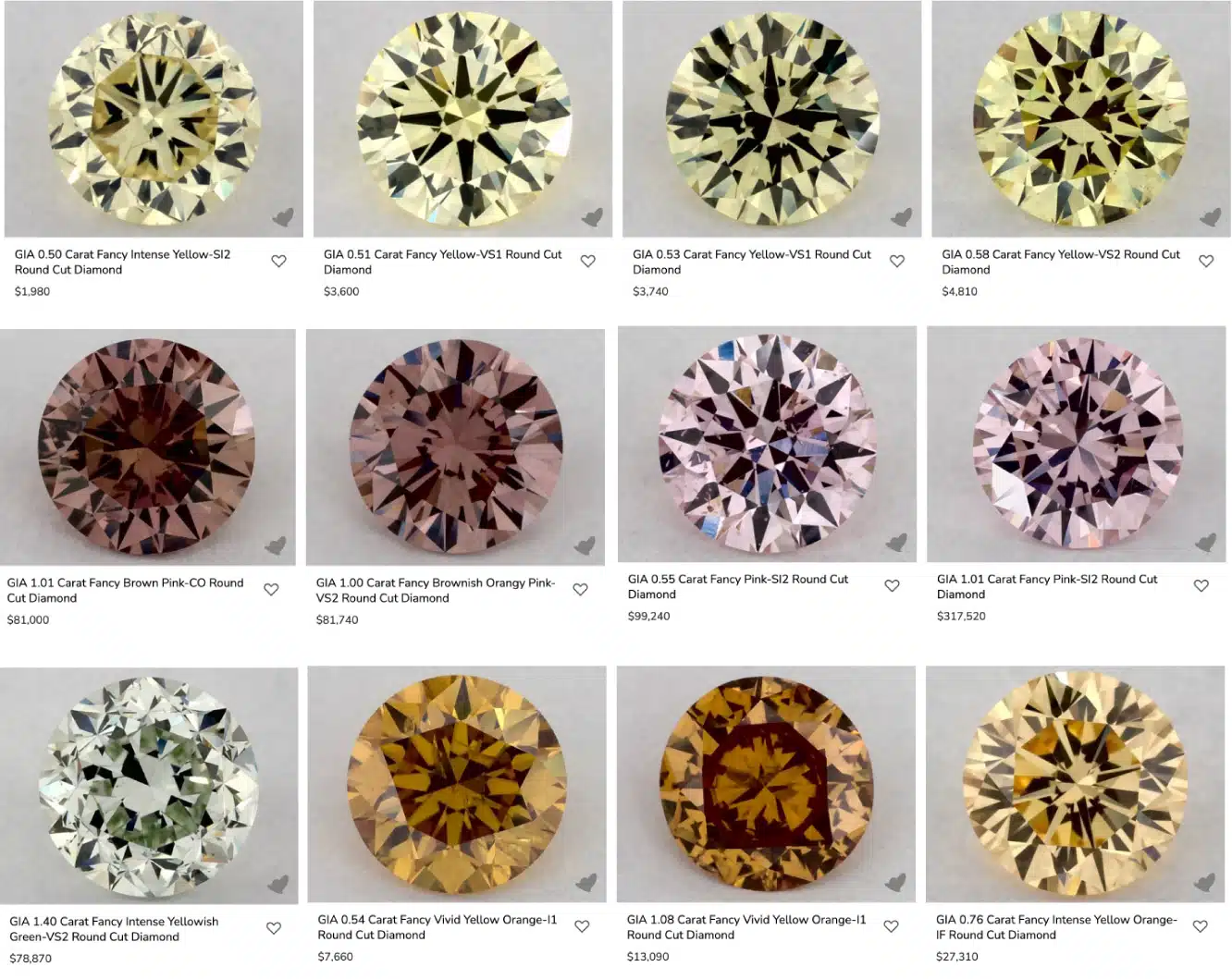
As you can see, you can start your search visually by clicking on the color you’re interested in. It’s an intuitive first step that gets you into the right ballpark immediately. From there, you can start filtering by intensity and price.
But here’s the most important thing to understand, and this is where the 360° videos become absolutely critical. Look at this gallery of actual fancy color diamonds from their site.
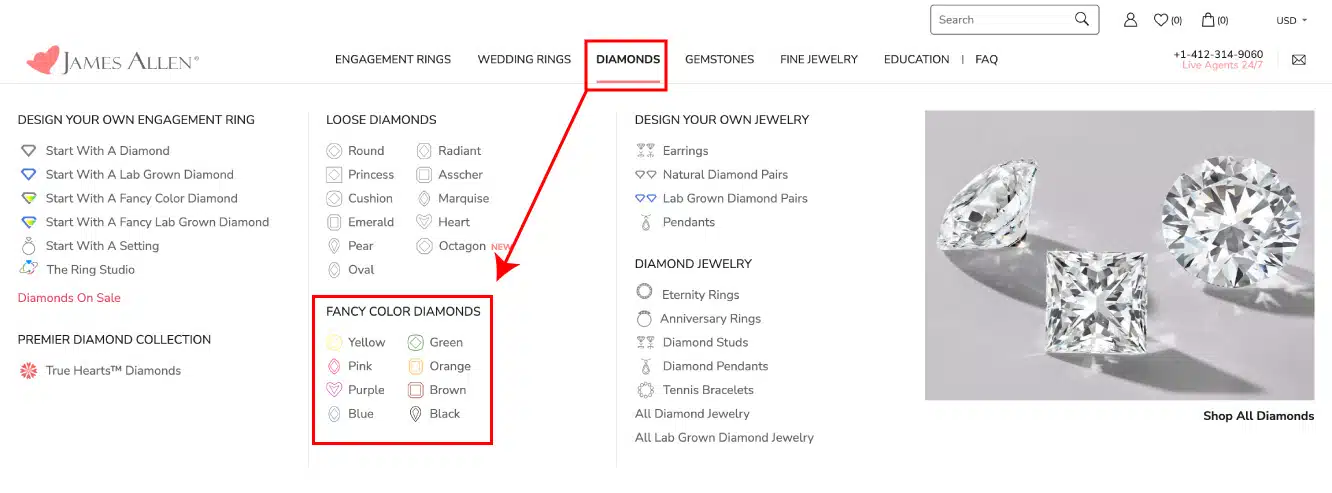
This isn’t just a pretty picture; it’s a masterclass in diamond economics.
Notice the 0.50-carat “Fancy Intense Yellow” on the top left? It’s under $2,000. Now glance over to the 1.01-carat “Fancy Pink—SI2.” The price tag? $317,520. Why? Because a gem-quality pink diamond is exponentially rarer than a yellow one. This gallery proves just how much rarity, not size or even clarity, dictates the price in this market.
Mehedi’s Brutally Honest Advice
- The Smart Money is on Lab-Grown: James Allen offers a great selection of lab-grown fancy color diamonds, primarily in yellow and pink. They are physically and optically identical to their natural counterparts but cost a tiny fraction of the price, making them an incredible option if you love the color but not the collector’s price tag.
- For Value, Go Yellow or Brown: These are the most common fancy colors and offer a fantastic, accessible entry point.
- For Rarity, Be Prepared to Pay: If you’re hunting for a pink, blue, or green diamond, the prices will be astronomical. This is collector territory. Don’t expect to find a 1-carat “Vivid Blue” just sitting there for a steal; they are among the rarest objects on earth.
The Diamond Hunter’s Playbook: How to Master the Filters
Alright, you’ve landed on the James Allen search page and you’re immediately faced with a wall of over 200,000 diamonds. It’s overwhelming. They all start to look the same, and that’s when you’re at risk of making a bad decision—either by giving up and picking one at random, or by overpaying for specs you don’t need.
This is where you stop thinking like a consumer and start thinking like a diamond hunter. The filters are your weapon, and I’m going to show you exactly how to use them to cut through the noise and find a stunner.
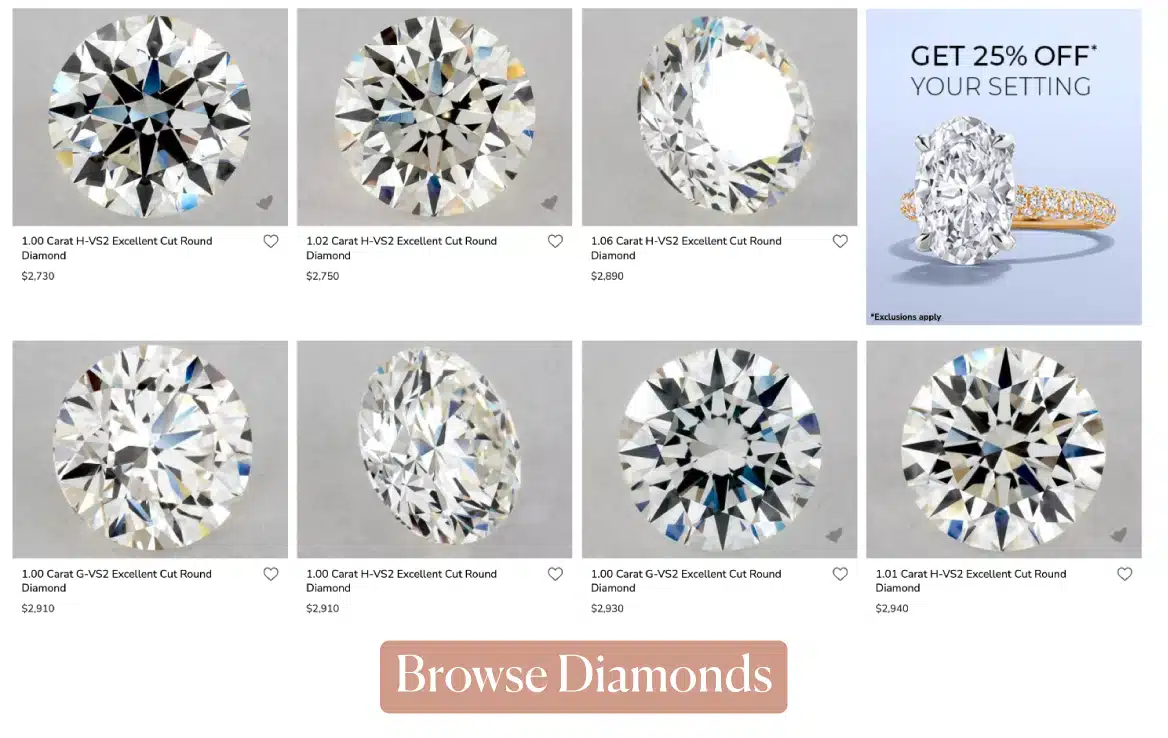
Mehedi’s “Set It and Forget It” Filter Settings
Don’t fiddle with every slider. For 99% of buyers, the goal is to find the best-looking diamond for the best price. To do that, we start by setting some non-negotiable baselines. These are the settings I use to instantly eliminate 80% of the low-performing or overpriced stones.
| Filter | My Expert Recommendation | The “So What” (Why It Matters) |
| Cut | Excellent (GIA) / Ideal (IGI/AGS) | This is non-negotiable. Cut is the engine of sparkle. Anything less and you’re buying a dull rock. Don’t even consider “Very Good.” This is the #1 rule. |
| Color | H or G | The G-H range is the value sweet spot. It appears perfectly white to the naked eye (especially in a white gold/platinum setting) without the D-F premium price. |
| Clarity | VS2 or SI1 | The goal is “eye-clean,” not “flawless on paper.” This is the range where you find beautiful diamonds with inclusions you’ll never see. This is where you save big. |
| Carat | 0.90-0.99 (if you want 1 ct) 1.40-1.49 (if you want 1.5 ct) 1.90-1.99 (if you want 2 ct) | The “buy shy” strategy. Prices jump at magic numbers (1.0, 1.5, 2.0). A 0.95-carat diamond looks identical to a 1.0-carat but can cost 15-20% less. |
Set these four filters, and you’ve just created a “kill zone” full of high-value, high-performance diamonds.
The “Pro Mode” Filters to Lock In Quality
Once the basics are set, we use the “Advanced Options” to make sure we’re only looking at the best of the best within our target group.
- Polish & Symmetry: Set both to Excellent. Think of this as the final fit-and-finish on a luxury car. “Excellent” ensures all the facets are perfectly polished and aligned, which is critical for maximizing light return.
- Fluorescence: Set it to None. While “Faint” is usually fine, “None” is the safest bet to ensure the diamond’s appearance won’t be negatively affected by a milky or hazy look in UV light (like direct sunlight). Our guide to diamond fluorescence breaks this down in detail.
- Lab Certification: Stick to GIA and IGI. These are the two most respected and consistent labs in the world. As I cover in my breakdown of the IGI certification, they are the gold standard for lab-grown diamonds, while GIA leads for natural stones.
By using this playbook, you transform an overwhelming inventory into a curated list of top contenders. From here, you can finally use James Allen’s superpower—the 360° video—to personally inspect your shortlist and hunt for the single best diamond in the group.
This is one of the most crucial things you need to know about James Allen before you buy; the power isn’t just in the selection, it’s in how you conquer it.
Beyond Diamonds: An Expert Look at Their Gemstones & Moissanite
While James Allen built its kingdom on diamonds, they’ve expanded their offerings to cater to a broader audience. So, if you’re not in the market for a traditional diamond, what are your options?
The short answer is: they have a curated but powerful selection. They focus on the most popular diamond alternatives and have recently made a very smart move by adding Moissanite to their lineup.

As you can see from their main navigation, their focus is split between the “big three” precious gemstones and the brilliant diamond-alternative, moissanite. Let’s break down where the true value lies.
The “Big Three”: Sapphires, Rubies, and Emeralds
James Allen offers a solid selection of the most popular precious gemstones: rich blue and pink sapphires, vibrant red rubies, and deep green emeralds. For someone looking to create a custom gemstone wedding band or a unique engagement ring, these are fantastic options.
Their 360° video is still incredibly useful here for judging cut quality and checking for obvious inclusions. However, here is my brutally honest advice, and it’s the same warning I give for Blue Nile: be extremely careful when judging gemstone color from a video.
The perfect studio lighting can make a gemstone’s color and saturation appear more intense than it will in your real-world environment. It’s a fundamental challenge of selling gemstones online.
The verdict: A great option for custom jewelry, but if the exact shade of blue is critical to you, it’s wise to use their “Real-Time Diamond Inspection” service to have a gemologist describe the color to you live.
The New Challenger (And a Game-Changer): Moissanite
This is the most exciting recent development at James Allen. They’ve finally added Moissanite to their official loose gemstone collection, which is a massive win for buyers focused on value.
So what is Moissanite? It’s a lab-created gemstone that is almost as hard as a diamond (9.25 on the Mohs scale) but has even more fire and brilliance (the rainbow sparkle). Best of all, it comes at a tiny fraction of the cost of even a lab-grown diamond. Our deep dive on 1-carat diamond vs. 1-carat moissanite shows just how dramatic the price difference can be.
By adding Moissanite, James Allen has created the ultimate value proposition for customers who want the biggest, most brilliant stone for their budget, period. While you can find loose moissanite on platforms like Amazon, buying it directly from James Allen means you’re getting a pre-vetted, high-quality stone that you can professionally set in one of their thousands of beautiful engagement ring settings.
The verdict: This is a fantastic addition. If your #1 priority is getting the most “wow” factor for your dollar, a James Allen Moissanite ring is one of the smartest buys you can make.
Emerald engagement rings come in a stunning array of hues, from yellow-green to blue-green, which only adds to their value. Choose your shade and follow your ring to THE emerald city.
The Big Decision: Natural vs. Lab-Grown Diamonds
Alright, let’s talk about the single most important choice you’ll make, a decision that will impact your budget more than anything else. Before you touch a single slider for color or clarity, James Allen forces you to pick a side in the industry’s biggest debate: Natural or Lab-Grown?

As you can see, this choice is front and center on their search page. It’s the very first filter because your answer changes the entire game. Understanding the stakes of this decision is the most crucial part of learning to build your own engagement ring like a pro.
So, let’s break down the brutally honest pros and cons of each, backed by the latest 2025 market data.
The Smart Money: The Overwhelming Case for Lab-Grown Diamonds
From a purely financial and visual standpoint, the case for lab-grown diamonds is almost impossible to argue with. Thanks to a massive 70-80% price collapse since 2020, lab diamonds are, without question, the smart money choice for maximizing your budget.
What does that mean in real-world numbers? For the price of a beautiful 1-carat natural diamond, you can often get a spectacular 2-carat (or even larger) lab-grown diamond of the same or better quality. For many buyers, that’s a no-brainer.
- They ARE Real Diamonds: Let’s be crystal clear. Lab diamonds are not fakes or simulants. They are chemically, physically, and optically identical to natural diamonds. A trained gemologist can’t tell the difference without advanced lab equipment.
- The Value Proposition: You get a significantly larger, higher-quality stone for your budget. Period. This is why their inventory has exploded to over 69,000 lab-grown options.
- The Only Catch (and it’s a big one): They have virtually zero resale value. Think of a lab diamond like a luxury car—it’s brilliant and high-performance the day you buy it, but it depreciates the second you drive it off the lot.
The Classic Choice: The Enduring Allure of Natural Diamonds
So if lab diamonds are such a steal, why would anyone still buy a natural one? The answer isn’t about logic; it’s about romance, rarity, and the concept of long-term value.
- The Story: A natural diamond is a billion-year-old piece of the earth. For many, that story—that connection to the natural world and deep time—is an integral part of its magic.
- The Rarity Factor: There is a finite number of natural diamonds in the world. This inherent rarity is what gives them their value.
- The Resale Value: While a natural diamond is not a stock market investment, it does retain a portion of its value in a mature, established resale market. You won’t sell it for what you paid, but it will always be worth something.
Comparison Table: The Bottom Line
| Feature | Natural (Earth-Mined) Diamond | Lab-Grown Diamond |
| Appearance | Optically identical to a lab diamond of the same GIA grade | Optically identical to a natural diamond of the same IGI/GIA grade |
| Price (2025) | Significant Price Premium | 70-80% Less than an equivalent natural diamond. |
| Resale Value | Holds some resale value (established secondary market) | Virtually none. Its value is in the initial purchase savings. |
| Origin Story | A billion-year-old marvel of nature | A marvel of modern technology |
| Ethical Note | Sourced via the Kimberley Process to be conflict-free | 100% conflict-free by origin |
My Brutally Honest Verdict: Which One Should You Buy?
As your friend in the business, here’s my straight answer:
- Buy a Lab-Grown Diamond if: Your #1 priority is getting the biggest, most beautiful, and visually impressive ring for your money. If the idea of getting a stunning 4-carat diamond ring on a realistic budget excites you, and you don’t care about resale value, lab-grown is the smartest choice you can make.
- Buy a Natural Diamond if: You are drawn to the romance and legacy of a stone created by the earth. If you view the ring as a timeless heirloom and want it to retain some financial value over the long term, then a natural diamond is the right choice for you.
There is no “wrong” answer here—only what’s right for your priorities and your wallet.
The Architect’s Playbook: How to Build Your Ring Like a Pro
Alright, you’ve mastered the filters and chosen your side in the natural vs. lab debate. Now comes the fun part: playing architect. James Allen’s “Build Your Own Engagement Ring” feature is where you move from a hunter to a designer.
This tool is the engine of their entire platform, and as I proved in my $16,350 undercover test, the final ring you receive is a perfect execution of the design you create on screen. But to get the best result, you need a strategy.
The Big Debate: Diamond First or Setting First?
James Allen’s navigation gives you multiple starting points, a flexibility that’s highlighted under their main “Engagement Rings” menu.
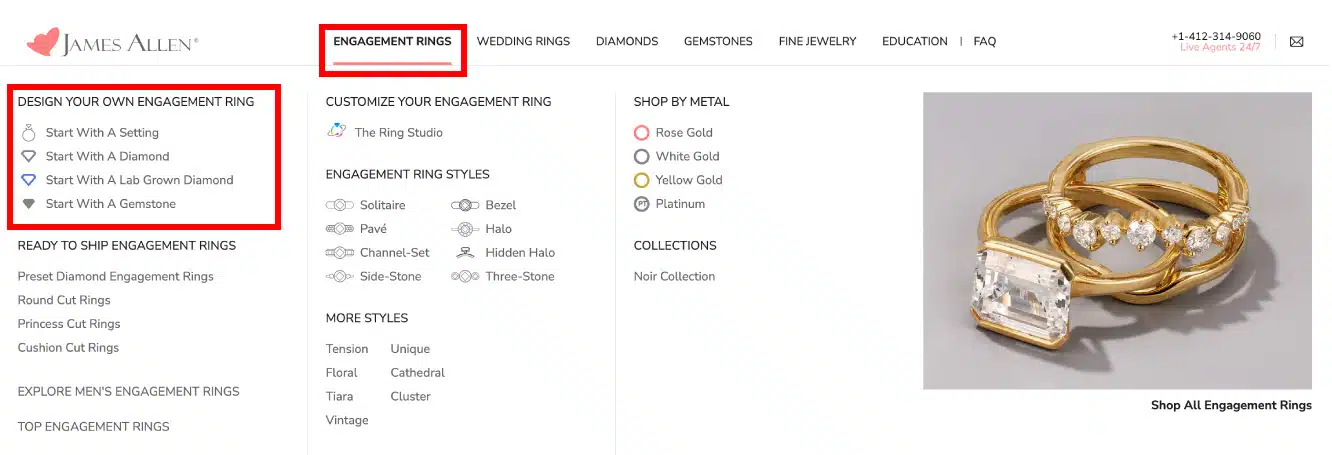
But which path should you choose? As your friend in the business, I’m here to give you the straight answer. For 9 out of 10 buyers, the answer is the same: Start with the diamond.
Why? Because the diamond is the engine of your ring. It dictates 80-90% of your budget and has the single biggest impact on the “wow” factor. By finding and securing the perfect stone first—one that meets your exact specs for cut, color, clarity, and carat—you know exactly how much budget you have left for the setting.
The only time you should start with the setting is if you (or your partner) are absolutely in love with a very specific, unique design (like a vintage halo or a tension setting) that only works with certain diamond shapes. For everyone else, lock in your diamond first. Our guide on how to build your own engagement ring dives deeper into this winning strategy.
Choosing Your Metal: The Smart Buyer’s Guide
The metal you choose affects the ring’s look, durability, and price. Here’s my no-nonsense breakdown:
- For White Metals, Choose 14k White Gold. It’s the industry workhorse for a reason. It’s more durable and affordable than platinum, and its bright white rhodium plating makes a G or H color diamond pop, making it look even whiter.
- If You Have a D-F Color Diamond, Consider Platinum. Its naturally white luster won’t ever fade, and it’s hypoallergenic. It’s a premium choice for a premium stone.
- For a Timeless Warmth, Go With Yellow Gold. An 18k yellow gold band with a colorless diamond is a stunning, classic combination that I personally love. It creates a beautiful contrast that highlights the diamond’s quality.
- For a Modern, Romantic Vibe, Choose Rose Gold. This trendy option is fantastic, especially with elongated shapes like ovals and pears.
Picking the Perfect Setting Style
James Allen has over 600 setting styles, but don’t get overwhelmed. They can all be broken down into a few key categories:
| Setting Style | My Brutally Honest Take | Best For… |
| Solitaire | The undisputed classic. It puts all the focus on the diamond. A timeless choice that never goes out of style. The safest bet, and often the most elegant. | Showing off a high-quality diamond. |
| Pavé | My personal favorite for adding serious sparkle for a relatively low cost. The band is lined with tiny diamonds, creating a “paved” look of continuous brilliance. | Maximizing the “bling factor” on a budget. |
| Halo | The ultimate way to make your center stone look bigger. The ring of tiny diamonds around the main stone can make it appear up to a half-carat larger. | Creating a big, bold look and enhancing the perceived diamond size. |
| Three-Stone | Rich with symbolism (past, present, future), this is a classic and substantial look. It’s incredibly elegant, especially with unique side stones like pears or baguettes. | A timeless, meaningful design with a lot of finger coverage. |
This process of combining your chosen stone with the perfect setting is the heart of what makes vendors like James Allen so powerful. It gives you the control and confidence that was once reserved for high-end custom jewelers, a key reason they stand out in our James Allen vs. Brilliant Earth comparison.
DIAMOND ON SALE!!
⏰ Tick-Tock! The Best Diamond Deals at James Allen Are Disappearing Fast!
The Price Showdown: An Expert Analysis of James Allen’s Value
Let’s tackle the question that’s probably on your mind: how can James Allen be so much cheaper than a traditional jewelry store? Is there a catch?
The answer is simple: they’ve cut out the middlemen and the expensive showrooms. By operating almost entirely online, they don’t have the massive overhead costs of a brick-and-mortar store, and they pass those savings directly to you. But a good price is meaningless if the quality isn’t there.
So, let’s do a live breakdown of a real diamond from their inventory to see exactly what you’re getting for your money and how to analyze it like a pro.
A Case Study: Deconstructing a $2,610 Diamond Listing
Here is a typical product page for a GIA-certified 1.00-carat diamond on their site.
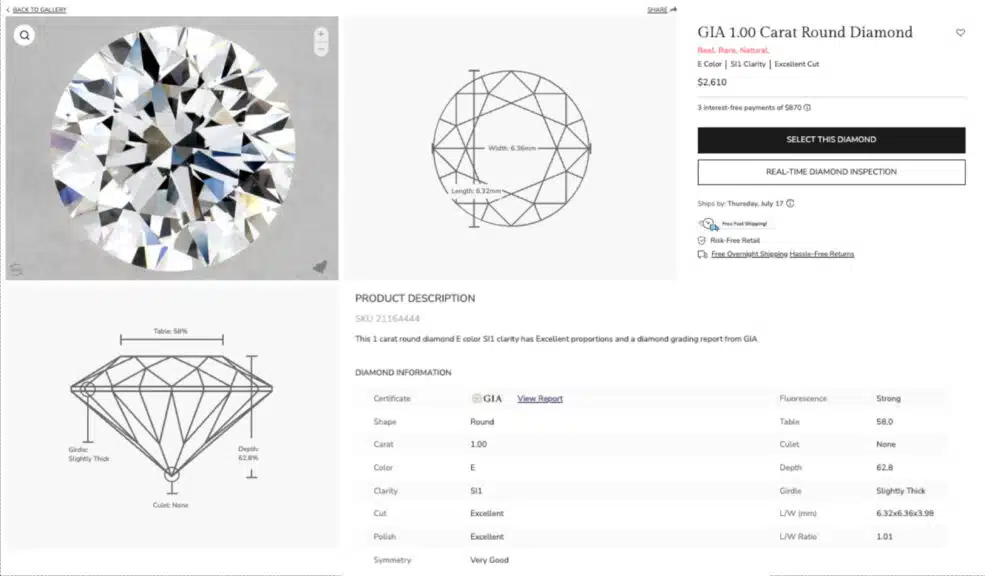
On the surface, this looks like a great deal. A 1.00-carat, E-color diamond for around $2,600 is an amazing price. But as your expert in the business, I’m here to show you how to look deeper.
- The Obvious Wins:
- The Price: At $2,610, the value is undeniable.
- The Cut: It has a GIA “Excellent” cut grade, which is my non-negotiable baseline for ensuring a diamond has brilliant sparkle.
- The Color: “E” is a premium, colorless grade. You’re getting a top-tier icy white appearance.
- The Potential “Red Flags” You Must Investigate:
- The Clarity: It’s an SI1 clarity diamond. This is the sweet spot for value, if it’s “eye-clean.” This is where you put the 360° video to work. You must zoom in and slowly rotate the stone to find where that “Slightly Included” imperfection is.
Is it a faint white feather near the edge (a great find!) or a dark crystal in the center (a deal-breaker)? This video is the only way to know. Our guide on SI1 clarity diamonds shows you exactly what to look for. - The Symmetry: It’s graded as “Very Good,” not “Excellent.” This might mean the facets aren’t perfectly aligned, which could slightly impact its light performance.
- The Fluorescence: It has “Strong” fluorescence. While often harmless, strong blue fluorescence can sometimes cause a high-color diamond to appear milky or hazy in direct sunlight. My guide to diamond fluorescence explains this risk in detail.
- The Clarity: It’s an SI1 clarity diamond. This is the sweet spot for value, if it’s “eye-clean.” This is where you put the 360° video to work. You must zoom in and slowly rotate the stone to find where that “Slightly Included” imperfection is.
This single listing proves why James Allen is legit: they give you all the data—the good and the potentially bad—and the tools to make an expert-level decision for yourself. They trust you to use the GIA certificate and the video to find the perfect stone.
Mehedi’s Hard Rules for Getting the Best Deal
Finding a diamond like the one above is a hunt. To get the absolute best value, follow these rules:
- Master the “Buy Shy” Strategy: Prices jump at “magic” numbers like 1.00, 1.50, and 2.00 carats. A 0.95-carat diamond looks identical to a 1.00-carat on the finger but can cost up to 20% less.
- Live in the “Eye-Clean” Zone: Don’t pay for flawless clarity you can’t see. Focus your hunt in the VS2-SI1 range and use the 360° video to find a stone with no visible inclusions to the naked eye. An eye-clean SI2 diamond is the ultimate find.
- Stick to G/H Color Grades: Unless you’re a purist with an unlimited budget, the D-F color range is often overkill. A G color diamond looks perfectly white and offers incredible value.
- Look for “Hearts and Arrows” on a Budget: You don’t always need to pay the premium for their official “True Hearts” collection. Use my guide to spotting Hearts and Arrows patterns to find visually perfect diamonds in their main inventory.
The Payment Playbook: How a Savvy Buyer Pays
How you pay for your ring is a strategic decision. Here’s my expert breakdown of the options at James Allen and which one you should choose.
| Payment Method | The Brutally Honest Breakdown | Who It’s For |
| Wire Transfer | The Pro Move. You get a 1.5% discount off the listed price. On a $10,000 diamond, that’s a free $150 in your pocket. It’s a no-brainer for larger purchases. | The savvy buyer who wants the absolute best deal. |
| 0% Financing | The Cash Flow Move. They typically offer 6 months of interest-free financing. CRITICAL WARNING: You must pay it off in full before the promo period ends, or you’ll be hit with high, retroactive interest on the entire original balance. | The disciplined buyer who wants to spread out the cost. |
| Credit Card | The Convenience Move. The easiest and fastest way to pay. You get your credit card points/rewards, but you’re paying full price. | The buyer who prioritizes ease and card rewards. |
A Note on Promotions and Financing
Beyond their already competitive base prices, James Allen frequently runs site-wide promotions, especially around holidays.
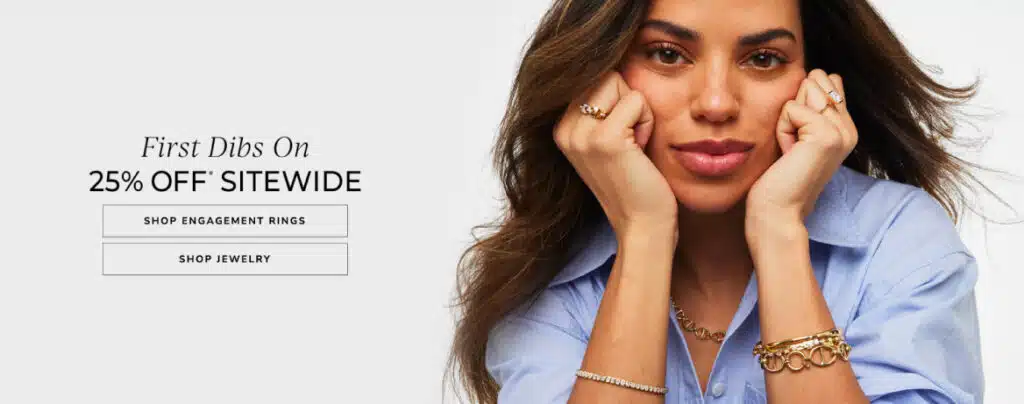
These sales can be a great way to close the small price gap they might have with a competitor like Ritani or save a few hundred dollars on your setting. Your best bet is to always check for current offers before you checkout. I keep a constantly updated list of the latest deals on our official James Allen Promotional Codes page.
They also offer flexible financing options to make a large purchase more manageable.
Decoding True Hearts™: A Gimmick or a Truly Perfect Diamond?
This is the million-dollar question for any savvy James Allen shopper. You’ve used the filters, you’ve found a few GIA “Excellent” cut diamonds you love, and then you see it: a nearly identical “True Hearts™” diamond for 10-15% more.
So, what’s the deal? Is it just a fancy name, or are you actually getting a better diamond? As your friend in the business, I’m going to give you the straight answer, and it starts with a secret the industry doesn’t like to talk about.
The “GIA Excellent” Problem
The GIA “Excellent” cut grade is the highest you can get, but it’s a very wide playing field. Think of it like an “A” grade in school. One student might get a 90, and another might get a 99, but they both get an “A.” The same is true for diamonds.
Some “Excellent” cut diamonds have good-but-not-perfect symmetry, leading to minor light leakage. They’re still brilliant, but they’re not perfectly brilliant.
True Hearts™ is James Allen’s filter for finding the 99-pointers. It’s their in-house Ph.D. program for diamonds that have already graduated from GIA’s master’s class.
The Proof Is in the Pattern: What “True Hearts” Actually Means
The “True Hearts” name is a direct reference to the “Hearts and Arrows” pattern, a visual phenomenon that only appears in round brilliant diamonds with near-perfect, three-dimensional optical symmetry.
It’s not a design; it’s the natural result of master-level craftsmanship. James Allen goes a step further by proving this to you with specialized images, allowing you to verify the diamond’s precision for yourself. For a full masterclass on this, my guide to Hearts and Arrows diamonds is essential reading.
For fancy shapes like the princess cut, “True Hearts” signifies that the stone has been hand-selected to optimize light performance and avoid common pitfalls for that shape, ensuring a vibrant, edge-to-edge sparkle.
The Head-to-Head: True Hearts vs. The Competition
The main rival to James Allen’s True Hearts is Blue Nile’s Astor collection. Both are premium cuts that promise superior light performance, and both command a higher price.
When I put them head-to-head in my Astor vs. True Hearts analysis, I found that both deliver on their promise of exceptional sparkle, but True Hearts often comes with better visual proof (the H&A imagery) for the buyer.
My Brutally Honest Verdict: Is True Hearts Worth It?
After analyzing thousands of these diamonds, my answer is a firm “it depends on who you are.” My full James Allen True Hearts review goes into exhaustive detail, but here’s the bottom line:
- You SHOULD Buy True Hearts if: You are a perfectionist who wants a guaranteed, top-tier, verifiably brilliant diamond without having to do the exhaustive research yourself. You are paying a slight premium not for a gimmick, but for a vetted, best-in-class stone. It’s the ultimate peace of mind.
- You should SKIP True Hearts if: You are a “value hunter” like me. If you enjoy the thrill of the chase, you can absolutely use the 360° videos and my filter playbook to find a “non-branded” diamond in their main inventory that has near-perfect Hearts and Arrows symmetry for a lower price. It takes more work, but it can be done.
Ultimately, True Hearts is proof that James Allen is a legitimate, high-quality diamond company. They care enough about cut quality to create and market a premium collection dedicated to it. Whether you pay the premium or hunt for a bargain, their system empowers you to get a spectacular diamond.
DIAMOND ON SALE!!
⏰ Tick-Tock! The Best Diamond Deals at James Allen Are Disappearing Fast!
The James Allen Safety Net: Service, Support & Smart Savings
Alright, we’ve talked a lot about hunting for value. But hunting for a deal online can feel risky. What happens if you make a mistake? What if you need help?
This is where James Allen’s second superpower comes into play: their customer service infrastructure. It’s not just a handful of helpful policies; it’s a complete safety net designed to give you the confidence to chase after the best possible value.
The customer feedback is consistently positive, with reviewers praising the entire end-to-end process.
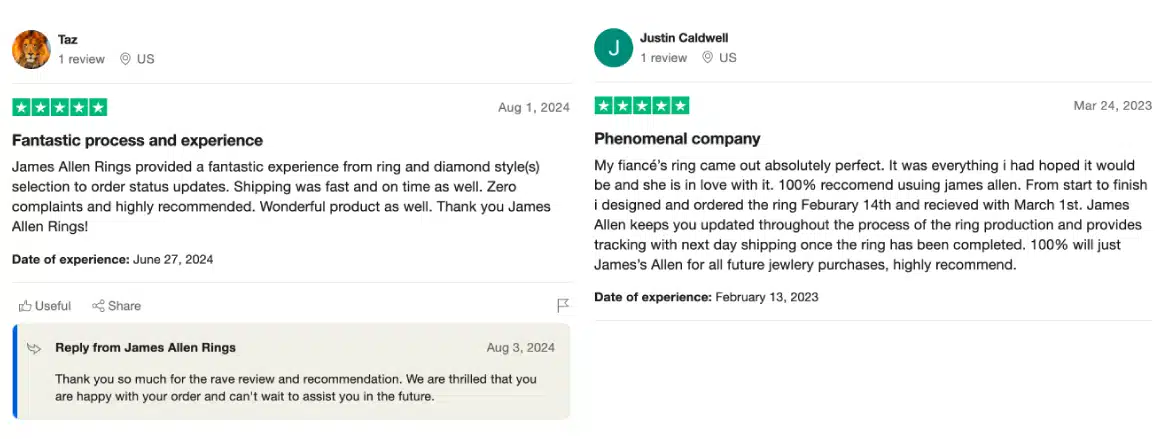
As reviewer Taz notes, it was a “fantastic process and experience from ring and diamond style(s) selection to order status updates.” Another buyer, Justin Caldwell, calls them a “Phenomenal company” and highlights how “James Allen keeps you updated throughout the process of the ring production.”
This high level of satisfaction is built on three key pillars.
Pillar 1: The Expert in Your Corner (24/7 Support)
This is your first line of defense. At any point in your diamond hunt—even at 2 AM—you can click the live chat button and be connected with a non-commissioned expert.
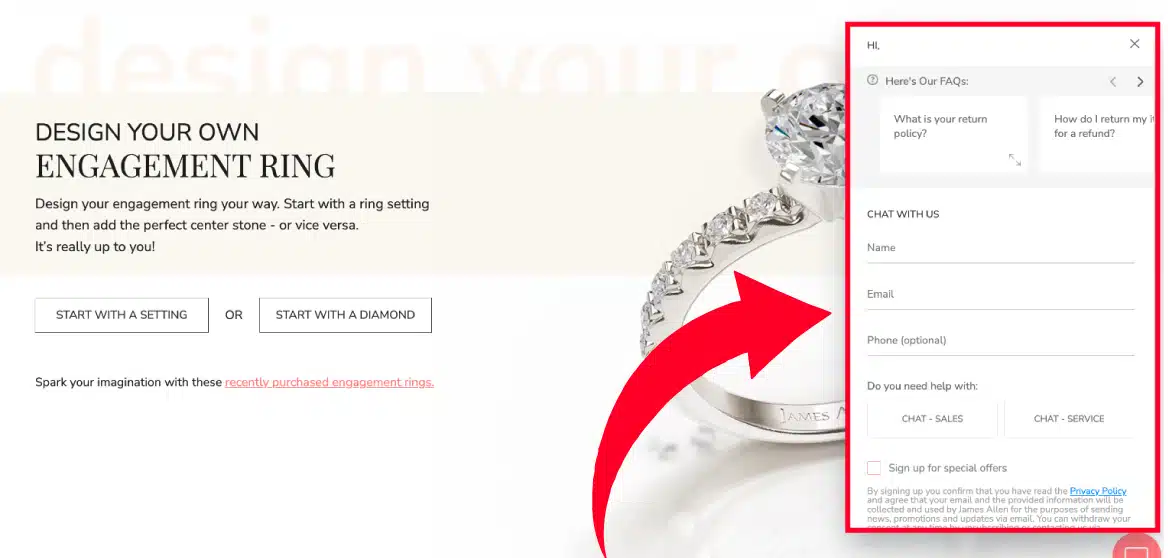
This is not a generic support team; they are trained gemologists who can give you an honest opinion on a diamond’s clarity, advise on a setting, or simply answer a policy question. This immediate access to expert, unbiased advice is one of the most important things to know about James Allen before you buy.
Pillar 2: The Ultimate Undo Button (Free Returns & Resizing)
This is the policy that makes value-hunting possible. James Allen’s 30-day, no-questions-asked, free-and-insured return policy is the ultimate safety net.
Did you try to save money with an SI1 diamond but don’t love it in person? Send it back, risk-free. Did you guess the wrong ring size? They offer one free resizing within the first year.
This removes the anxiety from the process and gives you the freedom to make the smart choice, not just the “safe” one. In my $16,350 undercover test, I personally verified this policy. The return was fast, seamless, and completely pressure-free.
Pillar 3: The Forever Promise (Lifetime Warranty)
Your protection doesn’t end after 30 days. James Allen’s free lifetime warranty is a serious long-term value add. It covers essential maintenance services like:
- Prong tightening (critical for keeping your diamond secure)
- Professional cleaning and polishing
- Rhodium plating (to keep white gold looking bright and white)
These are services that traditional jewelers often charge for, and they add up over time. This “forever promise” is their final commitment to the quality of your purchase, ensuring your ring looks as brilliant in ten years as it did the day you unboxed it.
Pillar 4: Your “Forever” Upgrade Path (The Lifetime Upgrade Program)
This is one of the most important—and misunderstood—policies James Allen offers. It’s their commitment to the long-term value of your purchase, acting as a built-in plan for future anniversaries or milestones.
Here’s how it works in plain English:
- 100% Credit: You receive the full original price of your natural diamond back as a credit.
- The “2x Rule”: The new diamond you select must be at least double the price of your original stone.
- Diamond for Diamond: The credit can only be used for a new loose diamond.
- The Certificate is Key: You must return the diamond in its original condition with its original GIA grading report.
My Brutally Honest Take: This is a fantastic policy that protects the sentimental value of your original purchase. It ensures you stay within their ecosystem, but it does so by giving you a powerful, value-retaining option that a local pawn shop never could.
Important note: This policy is typically for natural, earth-mined diamonds. Lab-grown diamonds, due to their depreciating value, are usually not eligible for this type of upgrade program.
The Architect’s Playbook: My Step-by-Step Guide to Building a Ring
Alright, you’ve done your research and you’re ready to build. This is where James Allen shines. Their “Build Your Own Engagement Ring” feature is the engine that drives their entire platform. As I proved in my $16,350 undercover test, the ring you design on screen is exactly the ring you get, with flawless execution.
But to get the best result, you need a strategy. I’m going to walk you through the exact process I use, step-by-step, to design a ring like a pro.
Step 1 & 2: Starting the Hunt (And Why to Always Start with the Diamond)
First, navigate to the “Engagement Rings” tab. You’ll immediately be given several starting points.

As you can see, you can start with a setting, a lab diamond, a natural diamond, or a gemstone. My professional advice for 9 out of 10 buyers is the same: always start with the diamond.
Why? Because the diamond dictates 80-90% of your budget and has the biggest impact on the final “wow” factor. Lock in your perfect stone first, and then you’ll know exactly what you have left to spend on a beautiful setting. For this guide, we’ll select “Start With A Diamond.”
Step 3: Conquering the Diamond Filters
This brings you to the main event: the diamond search page.
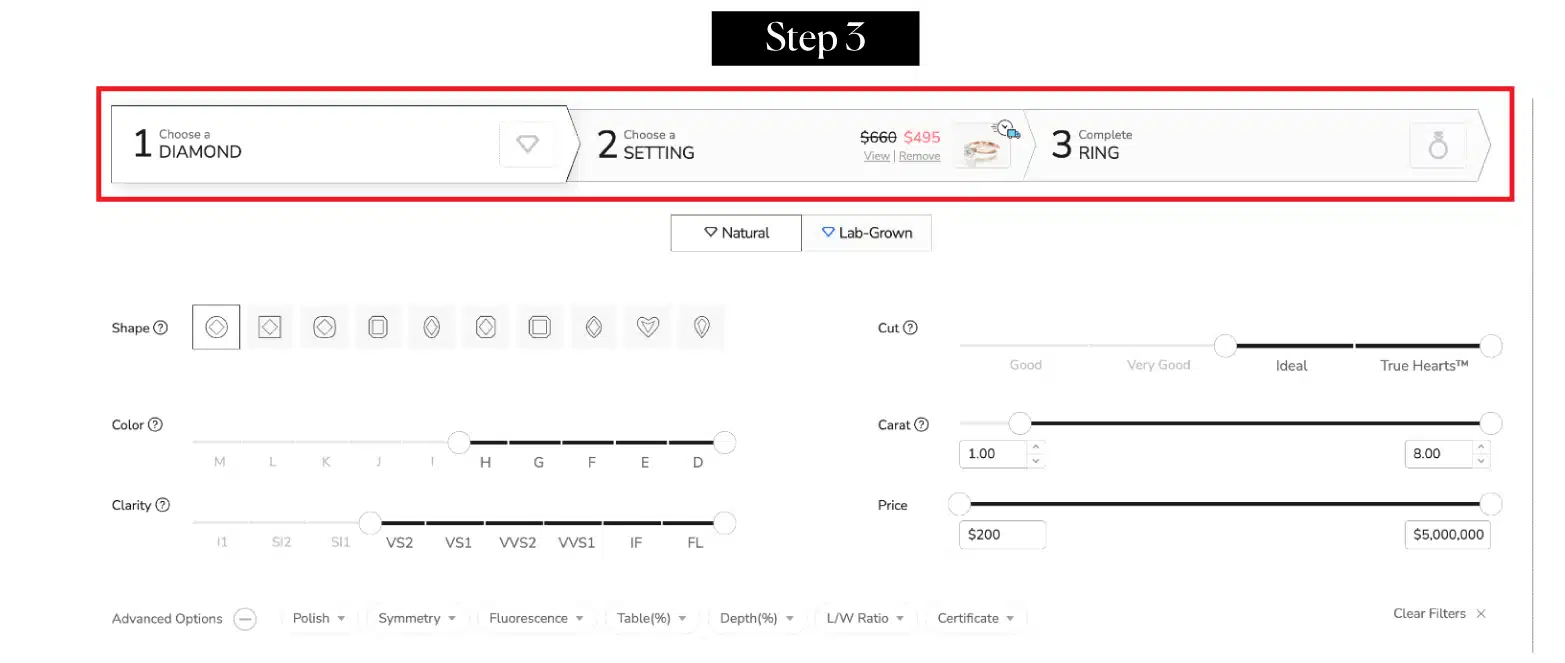
Don’t be intimidated by the hundreds of thousands of options. This is where we apply The Diamond Hunter’s Playbook we covered earlier. Set your non-negotiable baselines: Cut (Excellent/Ideal), Color (G or H), Clarity (VS2 or SI1), Polish/Symmetry (Excellent), and Fluorescence (None).
By setting these strong filters upfront, you instantly eliminate the noise and are left with a curated list of high-value, high-performance stones. This focused approach is the key to an effective DIY engagement ring build. Once you have your shortlist, you can use the 360° video to hunt for the single best eye-clean stone in the group.
Step 4: The Fun Part – Pairing it with the Perfect Setting
Once you’ve selected your diamond, the platform will seamlessly guide you to choose a setting. Here you can filter by style (solitaire, pavé, halo, etc.) and metal type (14k/18k gold, platinum). This is where your personal style comes into play. As I detailed earlier, a classic solitaire will put all the focus on your diamond, while a pavé or halo setting will maximize the overall sparkle.
The Final Sanity Check: The Virtual Try-On
You’ve built what you think is the perfect ring. It looks amazing on screen. But what will it look like on an actual hand? This is where James Allen’s clever “Virtual Try-On” feature comes in.
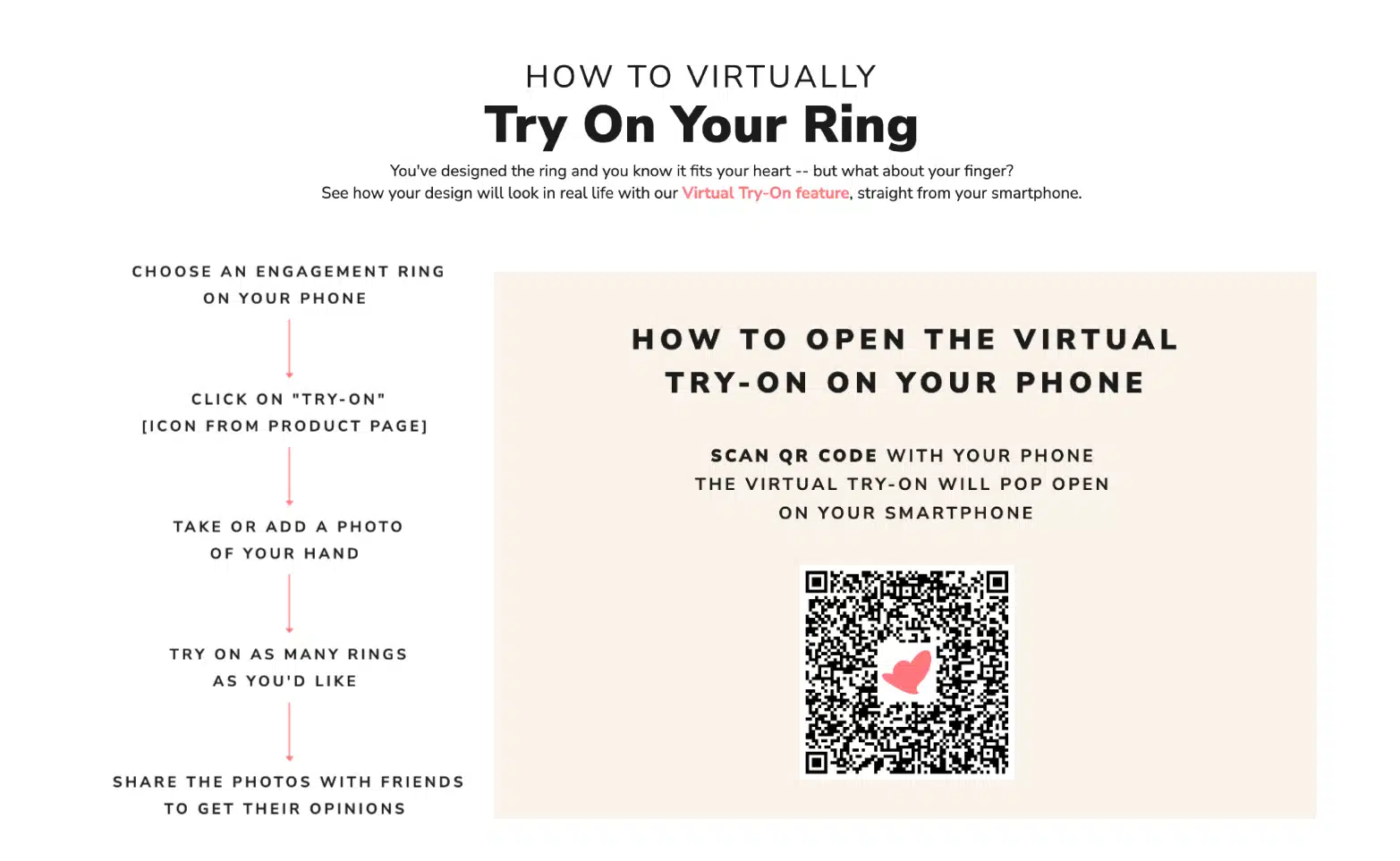
This tool is a fantastic final sanity check. You simply scan a QR code with your phone and upload a photo of a hand. The tool then superimposes the ring you’ve designed onto the photo, giving you a surprisingly accurate sense of the ring’s scale and proportions in a real-world context.
Is it a perfect substitute for trying on a ring in person? No. But is it an incredibly useful tool for confirming that the 2-carat oval you designed doesn’t overwhelm a petite hand, or that the delicate pavé band looks just right? Absolutely.
By following this strategic, step-by-step process, you transform the experience from an overwhelming guessing game into an exciting, confident, and highly personalized design journey.
Customer Highlight by Sarah L.: “The virtual try-on feature helped me find a style that suits my hand perfectly. I felt like I was in a jewelry store, all from home!”
A Critical Warning for International Buyers (Taxes, Duties & Fees)
James Allen proudly advertises “Free International Shipping,” and it’s true—they will send your ring via secure carrier (like FedEx or UPS) anywhere in the world at no cost. But do not mistake this for a tax-free purchase. This is a “gotcha” moment that trips up many first-time international buyers.
Here’s the unfiltered truth of what to expect if you’re ordering from outside the United States (e.g., in Canada, the UK, or Australia).
- You Are the Importer: When you buy from James Allen, you are the “importer of record.” This means you are responsible for any taxes and duties your home country charges.
- James Allen Does NOT Collect These Fees: The price you pay at checkout is only for the ring itself.
- You Will Pay the Carrier Directly: Your country’s customs agency will assess the required tax (VAT, GST, etc.) when the package arrives. The shipping carrier (FedEx/UPS) will pay this fee on your behalf to get it through customs quickly, and then they will send you a separate bill.
- You MUST Pay This Bill to Receive Your Ring: The carrier will not release the package to you until you have paid these import fees. This can add a significant amount (often 15-25% or more) to the total cost of your ring. Before you buy, I strongly advise you to research your country’s specific import duty and tax rates for jewelry.
The Competitor Gauntlet: A Brutally Honest 2025 Showdown
James Allen doesn’t exist in a bubble. They’re locked in a fierce battle with two other online giants: Blue Nile and Brilliant Earth. To give you the full picture, I’m putting all three head-to-head in a no-holds-barred comparison based on the latest 2025 data and my own expert analysis. This is where we declare a definitive winner for your specific needs.
The Main Event: James Allen vs. Blue Nile
This is the industry’s heavyweight championship. As of late 2025, both companies are owned by the same parent, Signet Jewelers, and their operations have become more similar. However, crucial differences remain.
- Technology: James Allen wins, but it’s close. Both now offer excellent 360° HD video on most of their diamonds. However, James Allen’s proprietary imaging still feels slightly superior, and their “Real-Time Diamond Inspection” screen-share with a gemologist is a game-changing feature Blue Nile can’t match.
- Natural Diamond Selection: It’s a tie. Both have a staggering inventory of over 160,000+ natural diamonds. You can’t go wrong with either for selection.
- Price: James Allen wins on diamonds; Blue Nile wins on settings. As my price analysis shows, for a 1-carat, G-VS2 natural diamond, James Allen is consistently priced lower. However, Blue Nile’s settings are often 20-30% cheaper, which can make a big difference in the final price. My full James Allen vs. Blue Nile guide breaks this down with real-world examples.
- Signature Cuts: In the battle of the best, my Astor vs. True Hearts analysis shows both offer superb light performance. True Hearts often comes with better visual proof (the Hearts & Arrows images), giving it a slight edge for perfectionists.
The Verdict: Choose James Allen if you prioritize the absolute best viewing technology and the lowest diamond prices. Choose Blue Nile if you find a setting you love, as the savings there can be significant.
The Value & Ethics Battle: James Allen vs. Brilliant Earth
This is a clash of philosophies. Brilliant Earth has built its entire brand on a “Beyond Conflict Free™” promise, focusing heavily on ethical sourcing and lab-grown diamonds.
- Natural Diamond Selection & Price: James Allen wins, decisively. James Allen has nearly three times the natural diamond inventory and is consistently priced lower. Brilliant Earth’s ethical sourcing premium is real, and you will pay more for an equivalent natural stone.
- Lab-Grown Diamond Selection: Brilliant Earth wins, massively. With over 300,000 lab diamonds, their selection dwarfs everyone else’s. If you are specifically hunting for a lab-grown stone, they offer the most choice.
- Ethics: Brilliant Earth wins, but with a caveat. Their commitment to traceability and community giving is commendable. However, as my deep-dive Brilliant Earth vs. James Allen review explains, their sourcing is still heavily reliant on supplier trust. James Allen is fully compliant with the Kimberley Process, ensuring your diamond is conflict-free, which is the industry standard.
- Customer Policies: It’s mostly a tie. Both offer 30-day returns and lifetime warranties, but James Allen offers a longer free resizing period (1 year vs. 60 days).
The Verdict: Choose Brilliant Earth if ethical branding is your #1 priority and you’re primarily shopping for a lab-grown diamond. For a wider selection of natural diamonds at a better price, James Allen is the clear winner.
The Price War: James Allen vs. Ritani
Now for the matchup that every hardcore value hunter asks about. Ritani has aggressively positioned itself as the price leader in the lab-grown diamond space, and frankly, they often win.
- Price: Ritani often wins, especially on lab diamonds. Their transparent pricing model sometimes undercuts everyone, including James Allen, by a noticeable margin. If your single-minded goal is the lowest possible price on a specific set of specs, you must check Ritani.
- Viewing Technology: James Allen wins, decisively. This is the trade-off. To achieve their rock-bottom prices, Ritani’s imaging is often less consistent and of lower quality. You might get a great video, or you might get a subpar one. James Allen’s 360° HD videos are the industry standard, giving you a far more reliable tool to inspect for clarity and cut quality.
- Customer Experience: James Allen has a more proven track record. While both have good policies, James Allen’s long-standing reputation for A+ customer service provides a greater sense of security for many buyers making a high-stakes purchase.
The Verdict: This is a classic “Price vs. Confidence” battle. Choose Ritani if you are an aggressive bargain hunter, comfortable with potentially less-detailed imagery, and focused solely on the best price. My Ritani vs. James Allen analysis shows the potential savings.
Choose James Allen if you are a “confident value hunter” who wants the peace of mind that comes with the industry’s best viewing technology.
The Ultimate 2025 Comparison: The Data-Driven Breakdown
To make this crystal clear, here’s a summary of my findings based on the most up-to-date 2025 market data.
| Feature | James Allen | Blue Nile | Brilliant Earth |
| Best For | Visual Inspection & Lab Diamond Value | Natural Diamond Selection & Lower Setting Prices | Ethical Branding & Lab Diamond Choice |
| 360° HD Video | Industry Best (on all stones) | Excellent (on most stones) | Good (natural light videos) |
| Natural Diamond Inventory | 164,000 – 185,000+ | 136,000 – 158,000+ | 54,000 – 76,000+ |
| Lab-Grown Diamond Inventory | Excellent (69,000+) | Excellent (68,000+) | Industry Leading (348,000+) |
| Price: 1-ct G VS2 Natural | ~ $2,540 – $4,210 (Typically the best value)** | ~ $3,130 – $5,190 | ~ $2,550 – $5,370 |
| Free Resizing | 1 Year | 1 Year | 60 Days |
| Customer Reviews Highlight | “Loved the ability to pick my stone in 360°… fantastic experience.” – Charlie, USA | “Got exactly what we wanted at a more reasonable price.” | “Love their mission and the unique, nature-inspired designs.” |
| Expert Criticism | Video sparkle can be exaggerated; settings are pricier. | Limited international perks; smaller lab diamond selection. | Ethical sourcing premium results in higher prices for natural diamonds. |
Ultimately, there is no single “best” vendor—only the best vendor for your specific priorities. This data-driven comparison gives you the power to make that choice with absolute confidence.
The Unfiltered Truth: A Deep Dive into James Allen Reviews on Reddit
My expert analysis and undercover tests are one thing. But what are real people—without a blog or a background in gemology—saying on the internet’s most brutally honest focus group, Reddit?
I’ve spent hours combing through dozens of threads in subreddits like r/EngagementRings and r/Diamonds. The consensus is a fascinating and critical mix of glowing praise and cautionary horror stories. As your friend in the business, I’m not here to hide the ugly parts. I’m here to dissect them and tell you what they really mean for your purchase.
The Glowing Reports: When Things Go Right, They Go Really Right
First, let’s be clear: a significant number of Reddit users report fantastic experiences with James Allen. These positive reviews almost always praise the exact strengths we’ve identified: the selection, the price, and the smooth initial buying process.
User interwebzusername sums up this positive experience perfectly:
“My husband had amazing customer service and we actually went to the DC showroom when we first looked… Cannot recommend James Allen enough.” Source
Another user, clarafrogs, confirms the longevity of their purchase after a year:
“They have held up great! I got them resized and soldered together a couple months ago but I haven’t had any issues with stones falling out or anything like that.” Source
This shows that when the system works—which is the vast majority of the time—the result is a high-quality, durable ring and a very happy customer.
The Red Flags: A Clear Pattern of Post-Purchase Problems
Now for the part you need to pay attention to. The negative James Allen reviews on Reddit are rare, but they are potent, and they almost all share a common theme: the problems don’t happen during the buying process, they happen after the sale with resizing, repairs, and customer service follow-up.
One of the most concerning stories comes from user Soft_Professional562, who sent a beautiful $10,000 platinum ring back for resizing and claimed it was “completely RUINED” in the process. He alleges:
“The thickness of the ring is not consistent… The shape of the edges of the band are no longer SQUARE as they advertised, they are ROUND. The platinum on the ring is completely over-worked. It looks like a kid took it to metal shop…” Source
Another user, tea621, tells a harrowing story of their center diamond falling out of its 6-prong platinum setting just a few months after purchase. Their frustration was less about the initial problem and more about the response from customer service:
“James Allen did not answer any of our questions, nor did they seem to care about the emotional stress of the situation… they generically told us we could mail in our diamond and expect there to be a 5-8 week turn around time on inspections/repairs.” Source
This highlights a critical risk: if you do encounter a problem, resolving it with a large, remote company can be a slow and frustrating process, especially compared to walking into a local jeweler.
My Expert Interpretation: What This Reddit Feedback Means for YOU
These stories are scary, but they are not the norm. They are, however, incredibly valuable because they reveal the specific stress points of James Allen’s high-volume business model. Here is my brutally honest breakdown of what these Reddit reviews actually mean.
- The “Big Box” Reality: As one Reddit moderator wisely put it, “JA is considered a big box store of online jewelry.” Like any massive operation—from Amazon to Walmart—the advantage is price and selection.
The disadvantage is that when something goes wrong, you risk becoming a case number in a large corporate system. The personalized service can sometimes be lacking, which is a stark contrast to my flawless return experience in the undercover test. - Setting Durability Is Your Responsibility: A recurring theme, like with user Tawanda87 whose pave stones fell out, is the failure of delicate, “whisper-thin” or shared-prong settings. As one commenter correctly notes, “Shared prong settings are trendy. So are those godforsaken ‘whisper thin’ bands. Neither is durable.” This isn’t just a James Allen issue; it’s an industry-wide one.
- My Actionable Advice (This is Important):
- Buy the Diamond, But Consider a Local Jeweler for Service: Based on this feedback, my professional recommendation is to leverage James Allen for what they do best: providing an incredible selection of GIA and IGI certified diamonds at a great price.
However, for post-purchase needs like resizing or intricate repairs, consider establishing a relationship with a trusted local jeweler. The extra peace of mind is worth it. - Choose a Durable Setting: If this is a ring that will be worn daily, especially by someone with an active job (like the nurse mentioned in one thread), avoid ultra-thin pavé bands under 1.8mm and delicate shared-prong settings. Opt for more secure settings like a classic solitaire, channel-set, or bezel-set design.
- Buy the Diamond, But Consider a Local Jeweler for Service: Based on this feedback, my professional recommendation is to leverage James Allen for what they do best: providing an incredible selection of GIA and IGI certified diamonds at a great price.
The consensus from Reddit confirms my own findings. James Allen offers a fantastic buying experience and incredible value, especially compared to a competitor like Brilliant Earth, who Redditors often criticize for higher prices. However, you need to be a smart, informed consumer. Choose your setting wisely for your lifestyle, and have a plan for long-term maintenance.
The Modern Dilemma: A Brutally Honest Guide to Natural vs. Lab-Grown
This is the single most important financial decision you’ll make when buying a ring. Forget color, forget clarity for a second. The first choice James Allen forces you to make is the big one: Natural or Lab-Grown? Your answer will change the entire scope of your budget.
So, let’s have a frank, no-BS discussion about this, backed by the latest 2025 market data.
First, Let’s Be Clear: Lab Diamonds ARE Real Diamonds
Don’t let anyone tell you otherwise. A lab-grown diamond is not a fake, a cubic zirconia, or a simulant. It is physically, chemically, and optically identical to a diamond mined from the earth. A trained gemologist cannot tell the difference without highly specialized equipment. They are both pure, crystallized carbon.
The only difference is their origin story: one is a marvel of nature, billions of years in the making; the other is a marvel of modern technology.
The Overwhelming Case for Lab-Grown: The Smart Money Choice
From a purely visual and financial standpoint, the argument for lab-grown diamonds is almost impossible to beat. Driven by fierce competition and incredible technology, the prices for lab diamonds have collapsed by a staggering 70-80% since 2020.
What this means for your wallet: For the price of a beautiful 1-carat natural diamond, you can often get a spectacular 2-carat (or even larger) lab-grown diamond of the same or better quality. It is, without question, the single best way to maximize the size and “wow” factor of your ring on any given budget.
The catch? And it’s a big one: Lab diamonds have virtually zero resale value. Think of them like a luxury car: brilliant, high-performance, and a fantastic value the day you buy it, but it depreciates the moment it’s yours.
The Enduring Allure of Natural Diamonds: The Heart’s Choice
So why would anyone still buy a natural diamond? The answer isn’t about logic; it’s about romance, rarity, and the concept of long-term value.
A natural diamond is a finite resource, a tiny piece of the earth’s history. That inherent rarity is what gives it its financial value. While a diamond is not a stock market investment, it does retain a portion of its value in a mature resale market. It’s a timeless heirloom with a legacy that, for many, is part of its magic.
The Competitive Landscape: Where to Hunt for the Best Lab Diamond
James Allen’s lab-grown selection is massive and fantastic. But as your friend in the business, I’d be doing you a disservice if I didn’t tell you to shop around. The lab diamond market is fiercely competitive.
While James Allen offers incredible value, true value hunters should always cross-reference prices with other major players:
- Blue Nile: As James Allen’s sister company, their lab diamond pricing is often very similar, but it’s always worth a quick look. Our James Allen vs. Blue Nile guide is your best resource here.
- Ritani: Known for their aggressive, transparent pricing, Ritani often tries to undercut the competition. They are a must-check when hunting for a lab stone. See the full breakdown in my Ritani vs. James Allen analysis.
- Vrai: A major player who has built their entire brand around lab-grown diamonds with a focus on sustainability.
My Final Verdict: The Head vs. The Heart
| Feature | Natural Diamond (The “Heart”) | Lab-Grown Diamond (The “Head”) |
| Appearance | Optically identical to a lab diamond of the same grade | Optically identical to a natural diamond of the same grade |
| Price (2025) | Massive Price Premium | 70-80% Less than an equivalent natural diamond. |
| Value | Holds some resale value due to rarity | Virtually none. The value is in the upfront savings. |
| Origin Story | A billion-year-old marvel of nature | A marvel of modern technology |
Buy a Lab-Grown Diamond if: Your #1 priority is getting the biggest, most beautiful, and visually impressive ring for your money, and you don’t care about resale value.
Buy a Natural Diamond if: You are drawn to the romance and legacy of a stone created by the earth, and you want it to retain some financial value as a timeless heirloom.
James Allen is a top leader in online diamond sales, offering cutting-edge imaging technology that lets you inspect diamonds as if you were using a jeweler's loupe. With the largest exclusive selection of loose diamonds available online and excellent pricing, they also boast one of the finest collections of lab-created diamonds on the market. They currently run a 25% discount on selected lab-grown diamonds!
WHAT WE LOVE ABOUT THEM:
- 30-day no-questions-asked return policy, with a prepaid shipping label provided by James Allen.
- Lifetime warranty on all purchases.
- Free international shipping.
- Complimentary prong tightening, repolishing, rhodium plating, and cleaning every six months.
- Insurance appraisals included with purchases.
- One free resizing within 60 days of purchase.
- Free ring inscriptions available.
- Best-in-class high-quality imagery for every diamond in stock.
- 24/7 customer support.
- Premium, best-in-class packaging.
The Unfiltered Truth: A Deep Dive into James Allen Reviews on Reddit
My expert analysis and undercover tests are one thing. But what are real people—without a blog or a background in gemology—saying on the internet’s most brutally honest focus group, Reddit?
I’ve spent hours combing through dozens of threads in subreddits like r/EngagementRings & r/Diamonds.
The consensus is a fascinating and critical mix of glowing praise and cautionary horror stories. As your friend in the business, I’m not here to hide the ugly parts. I’m here to dissect them and tell you what they really mean for your purchase.
The Glowing Reports: When Things Go Right, They Go Really Right
First, let’s be clear: a significant number of Reddit users report fantastic experiences with James Allen. These positive reviews almost always praise the exact strengths we’ve identified: the selection, the price, and the smooth initial buying process.
User interwebzusername sums up this positive experience perfectly:
“My husband had amazing customer service and we actually went to the DC showroom when we first looked… Cannot recommend James Allen enough.” Source
Another user, clarafrogs, confirms the longevity of their purchase after a year:
“They have held up great! I got them resized and soldered together a couple months ago but I haven’t had any issues with stones falling out or anything like that.” Source
This shows that when the system works—which is the vast majority of the time—the result is a high-quality, durable ring and a very happy customer.
The Red Flags: A Clear Pattern of Post-Purchase Problems
Now for the part you need to pay attention to. The negative James Allen reviews on Reddit are rare, but they are potent, and they almost all share a common theme: the problems don’t happen during the buying process, they happen after the sale with resizing, repairs, and customer service follow-up.
One of the most concerning stories comes from user Soft_Professional562, who sent a beautiful $10,000 platinum ring back for resizing and claimed it was “completely RUINED” in the process. He alleges:
“The thickness of the ring is not consistent… The shape of the edges of the band are no longer SQUARE as they advertised, they are ROUND. The platinum on the ring is completely over-worked. It looks like a kid took it to metal shop…” Source
Another user, tea621, tells a harrowing story of their center diamond falling out of its 6-prong platinum setting just a few months after purchase. Their frustration was less about the initial problem and more about the response from customer service:
“James Allen did not answer any of our questions, nor did they seem to care about the emotional stress of the situation… they generically told us we could mail in our diamond and expect there to be a 5-8 week turn around time on inspections/repairs.” Source
This highlights a critical risk: if you do encounter a problem, resolving it with a large, remote company can be a slow and frustrating process, especially compared to walking into a local jeweler.
My Expert Interpretation: What This Reddit Feedback Means for YOU
These stories are scary, but they are not the norm. They are, however, incredibly valuable because they reveal the specific stress points of James Allen’s high-volume business model. Here is my brutally honest breakdown of what these Reddit reviews actually mean.
- The “Big Box” Reality: As one Reddit moderator wisely put it, “JA is considered a big box store of online jewelry.” Like any massive operation—from Amazon to Walmart—the advantage is price and selection. The disadvantage is that when something goes wrong, you risk becoming a case number in a large corporate system.
The personalized service can sometimes be lacking, which is a stark contrast to my flawless return experience in the undercover test. - Setting Durability Is Your Responsibility: A recurring theme, like with user Tawanda87 whose pave stones fell out, is the failure of delicate, “whisper-thin” or shared-prong settings. As one commenter correctly notes,
“Shared prong settings are trendy. So are those godforsaken ‘whisper thin’ bands. Neither is durable.” This isn’t just a James Allen issue; it’s an industry-wide one. - My Actionable Advice (This is Important):
- Buy the Diamond, But Consider a Local Jeweler for Service: Based on this feedback, my professional recommendation is to leverage James Allen for what they do best: providing an incredible selection of GIA and IGI certified diamonds at a great price.
However, for post-purchase needs like resizing or intricate repairs, consider establishing a relationship with a trusted local jeweler. The extra peace of mind is worth it. - Choose a Durable Setting: If this is a ring that will be worn daily, especially by someone with an active job (like the nurse mentioned in one thread), avoid ultra-thin pavé bands under 1.8mm and delicate shared-prong settings. Opt for more secure settings like a classic solitaire, channel-set, or bezel-set design.
- Buy the Diamond, But Consider a Local Jeweler for Service: Based on this feedback, my professional recommendation is to leverage James Allen for what they do best: providing an incredible selection of GIA and IGI certified diamonds at a great price.
The consensus from Reddit confirms my own findings. James Allen offers a fantastic buying experience and incredible value, especially compared to a competitor like Brilliant Earth, who Redditors often criticize for higher prices. However, you need to be a smart, informed consumer. Choose your setting wisely for your lifestyle, and have a plan for long-term maintenance.
FAQs About James Allen
The Final Verdict: My Brutally Honest Recommendation
So, after the deep-dive analysis, the competitor showdowns, and the $16,350 undercover test, we land on the bottom line: what’s the final verdict on James Allen in 2025?
Here it is: James Allen’s entire system is built on one radical and powerful idea: that you should be the expert.
They have systematically dismantled every barrier that once stood between a regular person and a smart diamond purchase. They replaced the intimidating jeweler’s loupe with a 40x high-definition video, the limited in-store tray with a vault of over 200,000 diamonds, and the high-pressure salesperson with a 24/7 team of non-commissioned gemologists.
They are not just a store; they are an arsenal of tools designed to give you an unfair advantage.
The James Allen Review: Pros and Cons
| The Wins (Pros) | The Drawbacks (Cons) |
| Industry-Best 360° Video: Puts a virtual loupe in your hands for every diamond. | Slightly Pricier Settings: Their engagement ring settings often cost more than Blue Nile’s. |
| Massive Lab-Grown Selection: A huge inventory with market-leading value. | “True Hearts” Premium: You’ll pay a 10-15% premium for their branded signature cut. |
| Proven A+ Customer Service: Their 24/7 support and return policy are rock-solid. | Limited Fashion Jewelry: Their selection beyond engagement rings is small. |
| Free Lifetime Warranty: Covers cleaning, prong tightening, and replating for life. | Video Sparkle Can Be Misleading: The intense studio lighting can make all diamonds look fiery. |
| Unmatched Transparency: From GIA reports to real-time inspections, you see everything. | Inventory Moves Fast: High-value, eye-clean SI1 diamonds sell very quickly. |
My Final Recommendation: Who Should (and Shouldn’t) Buy from James Allen?
This is where the rubber meets the road. Based on my comprehensive analysis, here’s who will love James Allen.
You SHOULD absolutely buy from James Allen if:
- You’re a Visual Perfectionist: If you’re the kind of person who wants to inspect every facet, hunt for the perfect eye-clean SI1, and feel 100% confident in what you’re buying, their video technology is your holy grail.
- You’re a Smart Value Hunter: Their system is built for you. By combining the video tool with my filter playbook, you can find a diamond with superior visual performance for a fantastic price.
- You’re Buying a Lab-Grown Diamond: With a massive selection, great pricing, and the best viewing technology, they are arguably one of the best and safest places to buy a lab-grown diamond online.
…And You should consider a competitor if:
- Your #1 Priority is the Absolute Lowest Price: While James Allen is incredibly competitive, a true price absolutist should always cross-reference with Ritani, who can sometimes win on price by a small margin.
- You Found the Perfect Setting for Less at Blue Nile: As my James Allen vs. Blue Nile comparison shows, Blue Nile’s settings can be significantly cheaper. If your heart is set on a specific style, it’s worth a price check.
- You Prioritize an Ethical Brand Story Above All: While James Allen is 100% conflict-free, a company like Brilliant Earth has built its entire brand around a “Beyond Conflict Free™” mission, which may align better with your values.
Ultimately, James Allen has more than earned its place at the top of the online jewelry world. They have created a platform that delivers not just a beautiful diamond, but something far more valuable.
You’re not just buying a diamond; you’re buying the unshakable confidence that you made the right choice.
You’ve got the knowledge. You’ve got the tools. You’ve got this.


